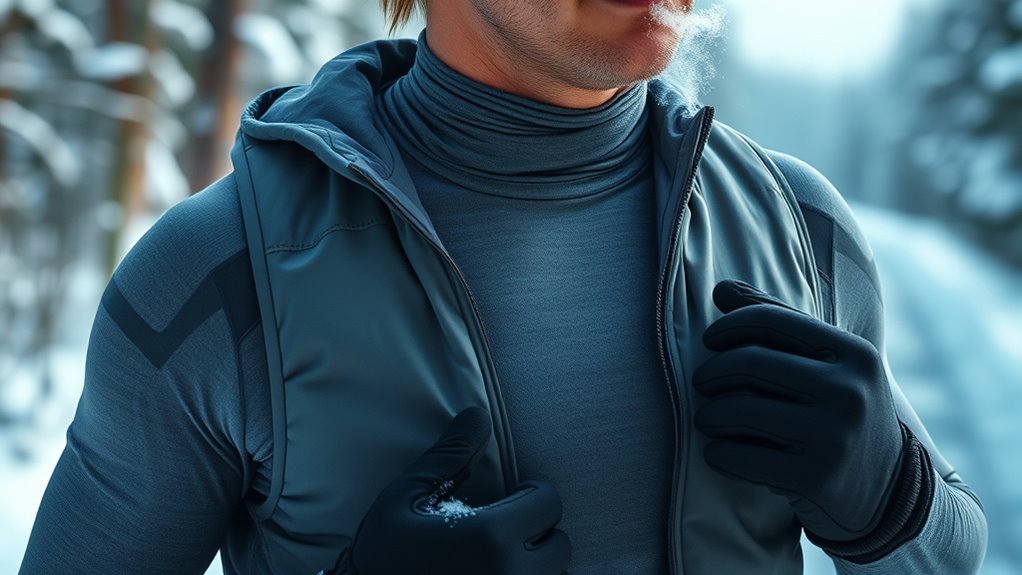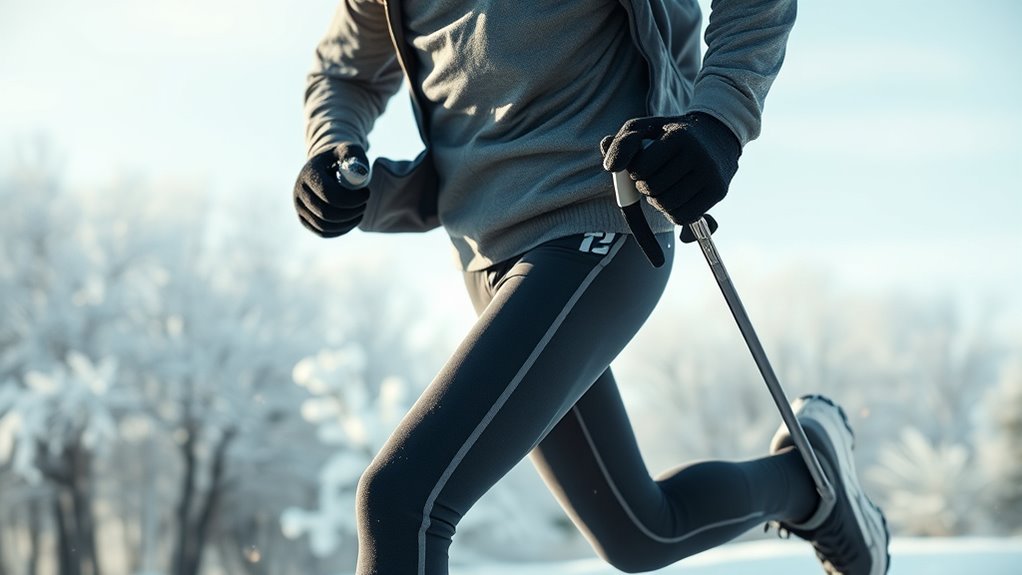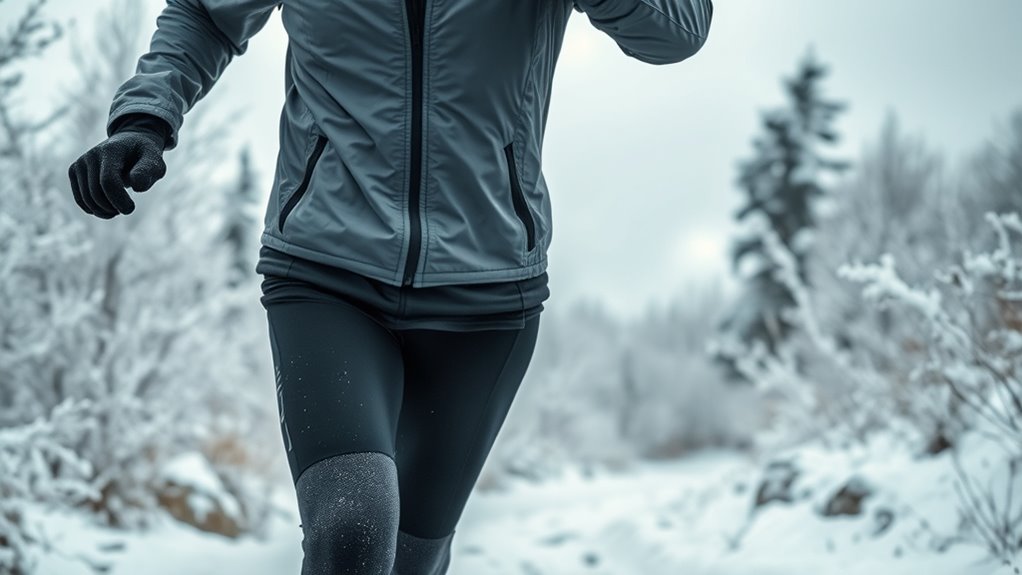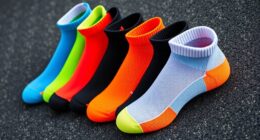To stay warm and dry during winter runs, use a three-layer system. Start with a moisture-wicking base layer that pulls sweat away from your skin and fits snugly. Add an insulating layer like fleece to trap heat while allowing breathability. Finish with an outer shell that blocks wind, snow, and rain but remains breathable. Proper layering guarantees comfort and safety in any winter weather—keep going to discover how to optimize each layer for your runs.
Key Takeaways
- Start with a moisture-wicking base layer to keep sweat away from your skin and prevent chill.
- Add an insulating layer like fleece or down to trap heat while maintaining breathability.
- Finish with a windproof and waterproof outer layer to shield against wind, snow, and rain.
- Ensure all layers fit snugly but allow freedom of movement for effective moisture transfer.
- Adjust layers based on weather conditions to stay warm, dry, and comfortable during your run.
Base Layer: The Foundation for Warmth and Moisture Management

A good base layer is essential for winter running because it directly impacts your warmth and moisture control. You want clothing made from moisture wicking fabrics that pull sweat away from your skin, keeping you dry and comfortable. Breathability features are equally important, allowing excess heat and moisture to escape and preventing overheating. Look for materials like merino wool or synthetic blends designed for active wear, which efficiently manage sweat and temperature. Avoid cotton, as it traps moisture and leaves you feeling cold and damp. Your base layer should fit snugly but not restrict movement, ensuring maximum contact with your skin for ideal moisture transfer. Additionally, selecting fabrics with Breathability features can enhance temperature regulation during your run. When chosen carefully, a quality base layer sets a solid foundation for the rest of your winter running gear.
Insulating Layer: Trapping Heat and Maintaining Comfort

After establishing a moisture-wicking base layer, adding an insulating layer helps retain body heat and keeps you comfortable during winter runs. This layer is vital for thermal retention, preventing heat from escaping and ensuring you stay warm in cold conditions. Choose materials like fleece or down that trap heat effectively while still allowing some breathability. Striking a breathability balance is key—if your insulation is too thick, moisture can build up and cause discomfort; if too thin, it won’t provide enough warmth. Focus on lightweight, insulating fabrics that maintain warmth without restricting movement. Proper color accuracy in your clothing choice can also help you assess the warmth and reflectivity of your gear in varying light conditions. Incorporating thermal regulation techniques can further optimize your comfort by managing sweat and moisture. Additionally, selecting garments made from natural materials can enhance breathability and moisture management, contributing to a more comfortable run. By properly insulating, you create a cozy barrier that preserves your body heat while maintaining enough breathability to prevent overheating or sweat buildup.
Outer Layer: Protecting Against Wind, Snow, and Rain

To stay protected against the elements during winter runs, your outer layer must effectively block wind, snow, and rain. Look for materials with excellent breathability benefits to prevent overheating and moisture buildup inside your clothing. A breathable outer layer allows sweat to escape while keeping external moisture out, ensuring comfort throughout your run. Material durability is equally important; choose gear that withstands rough conditions, resisting tears and abrasions from snow and wind. Waterproof or water-resistant fabrics are ideal for keeping you dry, while windproof features reduce heat loss. Prioritize a lightweight design that offers freedom of movement without sacrificing protection. Incorporating active listening and empathy into your gear choices can enhance your awareness of weather conditions, helping you adjust layers accordingly. Paying attention to weather responsiveness in your gear can further improve your comfort and safety. Additionally, selecting an outer layer with proper ventilation can prevent moisture accumulation inside, keeping you dry and comfortable. Considering beach weather variations and how they affect clothing choices can help you stay prepared for unexpected weather shifts. With the right outer layer, you’ll stay warm, dry, and comfortable, ready to face winter’s toughest weather.
Frequently Asked Questions
How Do I Prevent Chafing With Multiple Layers During Winter Runs?
To prevent chafing with multiple layers during winter runs, focus on layering durability and skin irritation prevention. Choose moisture-wicking, seamless fabrics that reduce friction and keep your skin dry. make certain layers fit well—too tight causes chafing, too loose causes rubbing. Apply anti-chafing balm on sensitive areas, and consider wearing fitted base layers to minimize skin irritation. Proper layering and skin care keep chafing at bay, even in cold conditions.
What Fabrics Are Best for Moisture-Wicking in Cold Weather?
For moisture-wicking in cold weather, choose synthetic fabrics like polyester or nylon, which actively pull sweat away from your skin and dry quickly. Natural fibers like merino wool are also excellent because they regulate temperature and wick moisture effectively while feeling soft. Avoid cotton, as it traps moisture and can make you cold. Combining synthetic and natural fibers guarantees you stay dry, warm, and comfortable during winter runs.
How Should I Adjust Layers for Changing Winter Temperatures?
Did you know that your body loses heat 25% faster in cold air? As temperatures change, you should adjust your layers to optimize temperature regulation. If you start feeling too warm, remove a layer to prevent overheating. Conversely, add an extra layer if it gets colder. This simple approach keeps you comfortable, prevents sweat from cooling too quickly, and guarantees you stay safe and energized during your winter runs.
Can Layering Strategies Differ for Trail Running Versus Road Running?
Yes, your layering strategies should differ for trail versus road running. For trail running, use layering materials that offer better moisture-wicking and insulation, and include trail-specific gear like gaiters and durable outer layers. On the road, focus on lightweight, breathable layers that protect against wind and cold. Adjust your layers based on terrain, ensuring you stay warm and dry, while also maintaining flexibility for varied trail conditions.
What Accessories Can Enhance Warmth Without Adding Bulk?
You can enhance warmth without bulk by choosing the right accessory options. Look for thermal gear like headbands, neck gaiters, and gloves made from moisture-wicking, insulating fabrics. These accessories trap heat effectively while remaining lightweight and flexible. They’re easy to pack and remove if you overheat. Incorporating these accessories guarantees you stay warm during winter runs without feeling bulky or restricted, keeping your focus on your performance.
Conclusion
By mastering this three-step layering formula, you build a fortress against winter’s chill, turning your run into a dance through the cold instead of a battle. Think of your layers as an orchestra working in harmony—each piece essential, each note precise. When you choose your base, insulation, and outer layer wisely, you create a symphony of warmth and protection. Embrace this foolproof method, and winter’s grip will never hold you back from hitting the pavement.








